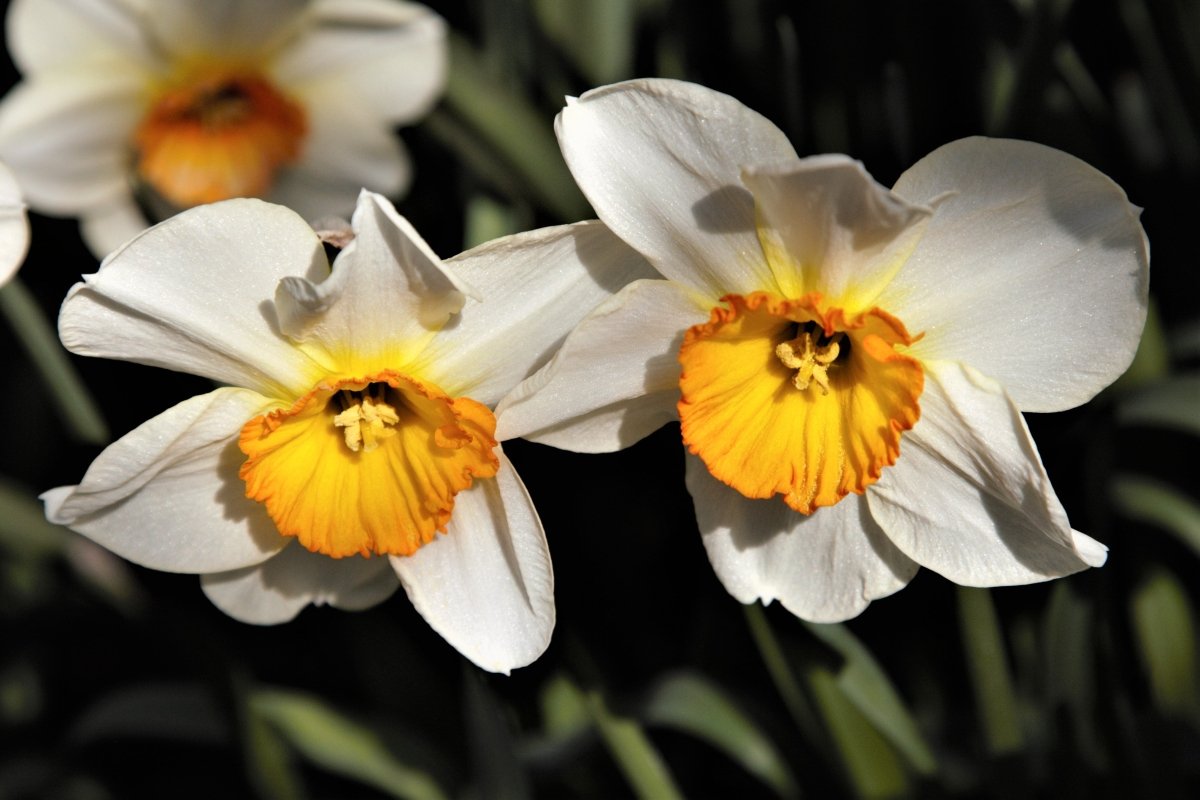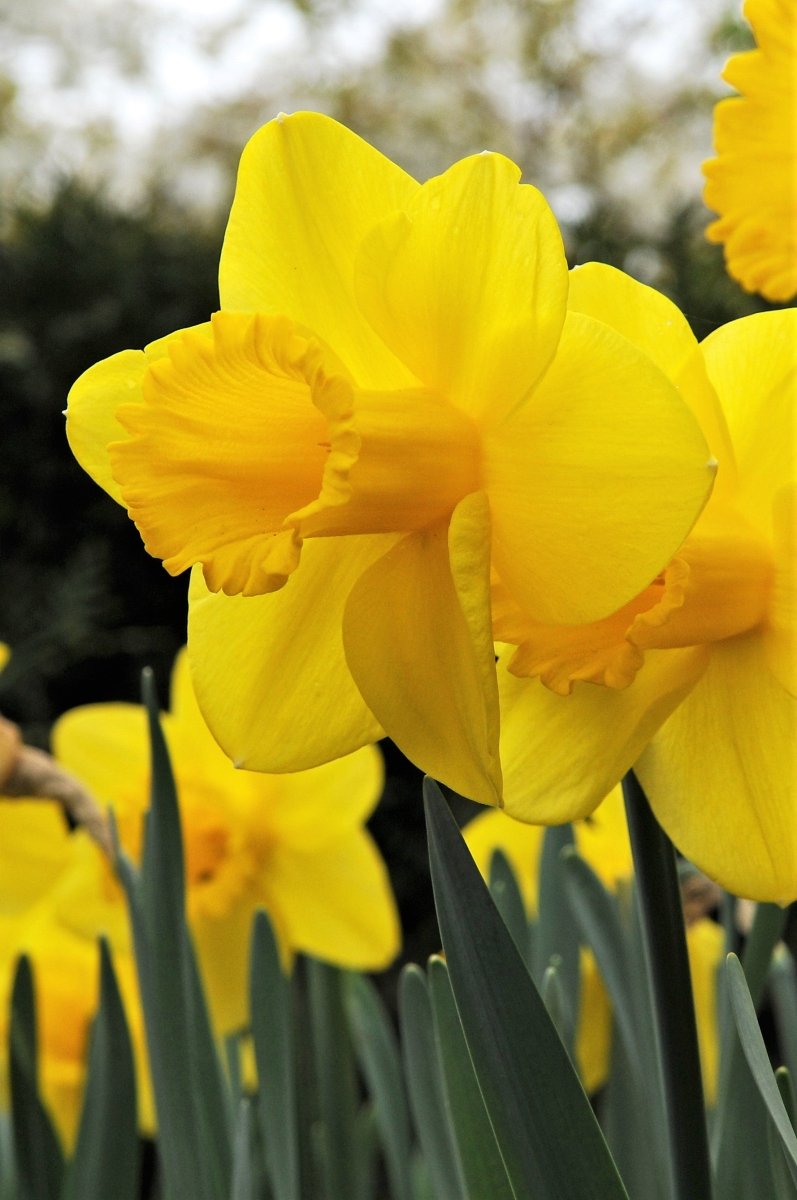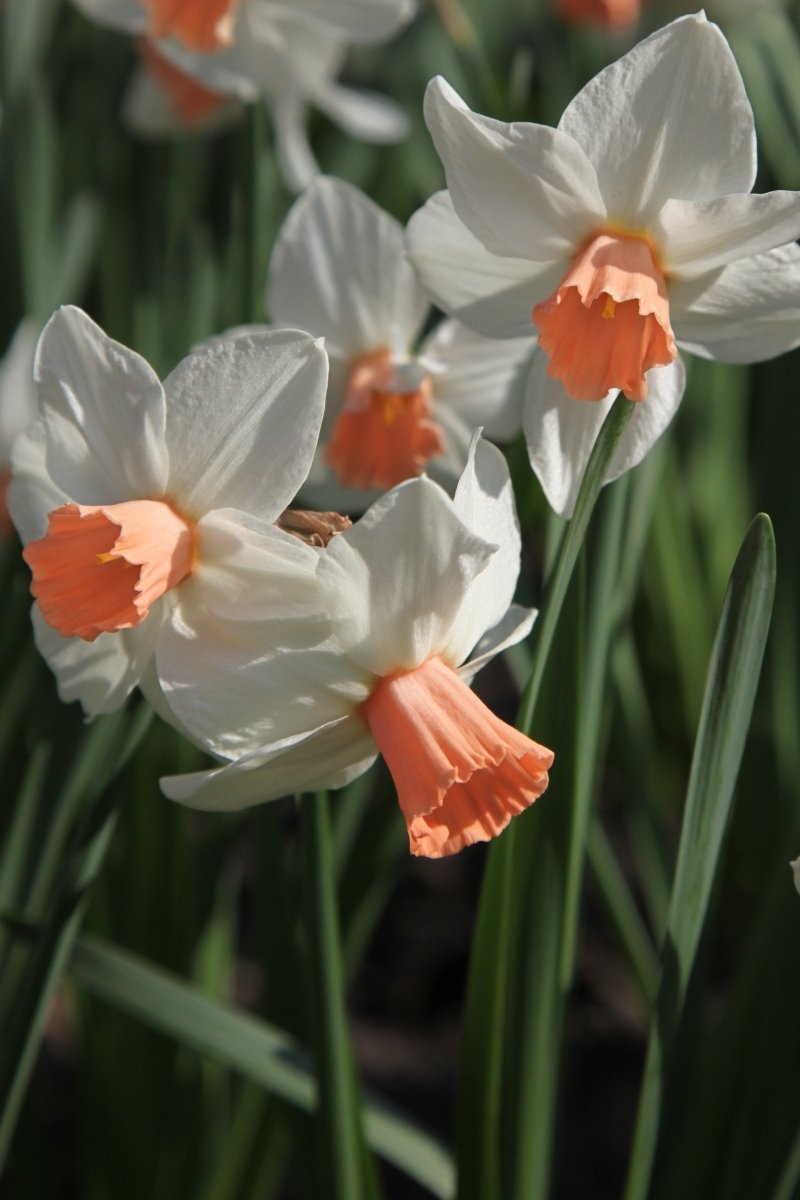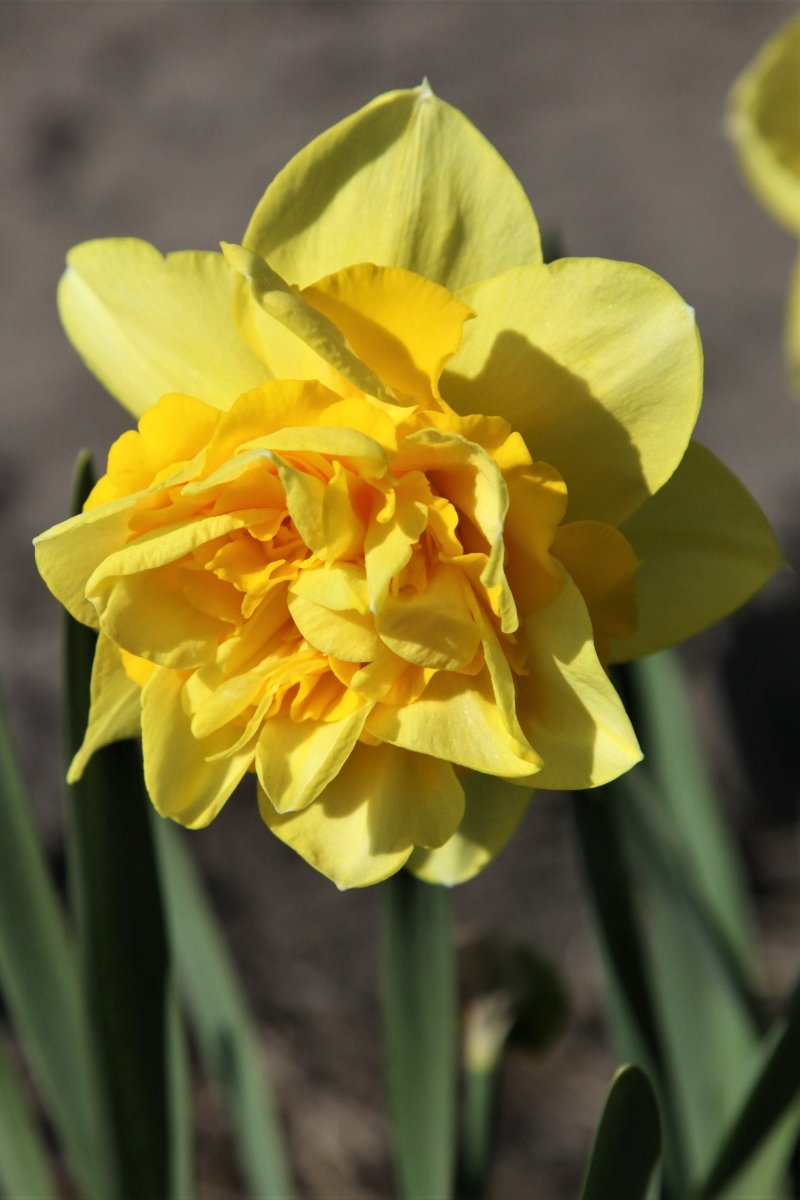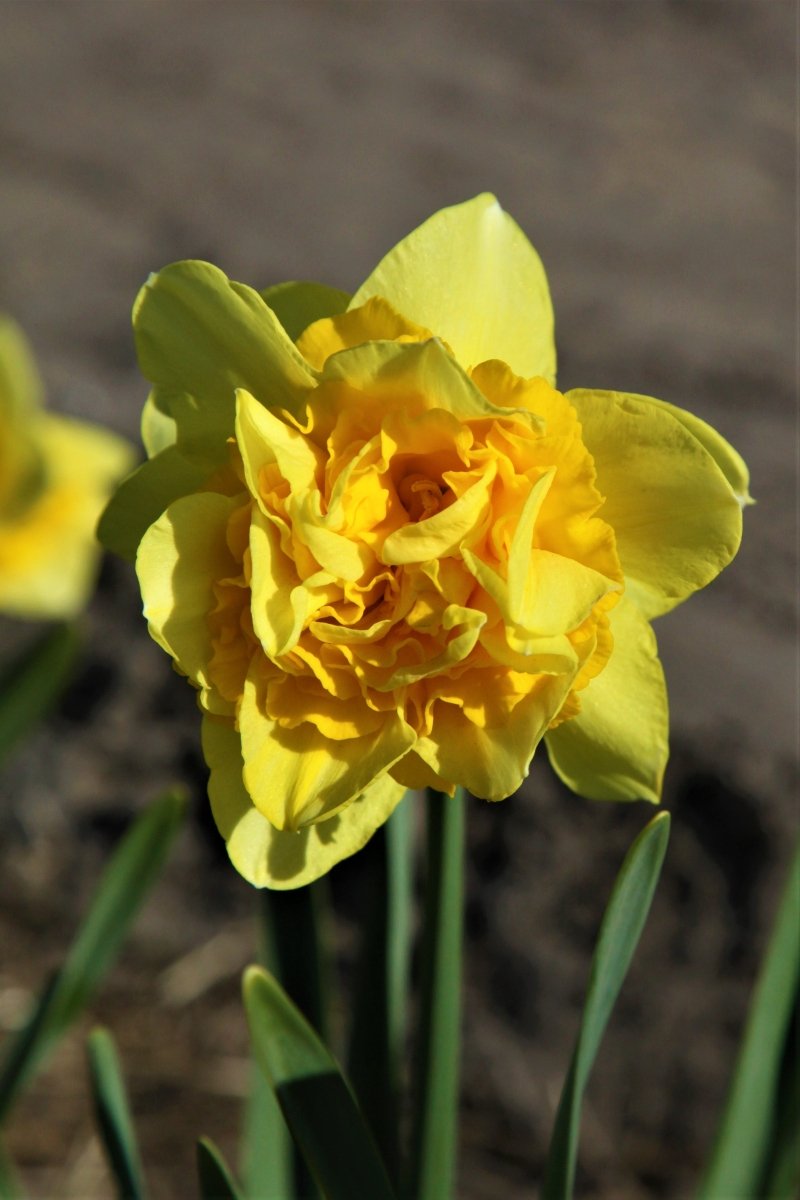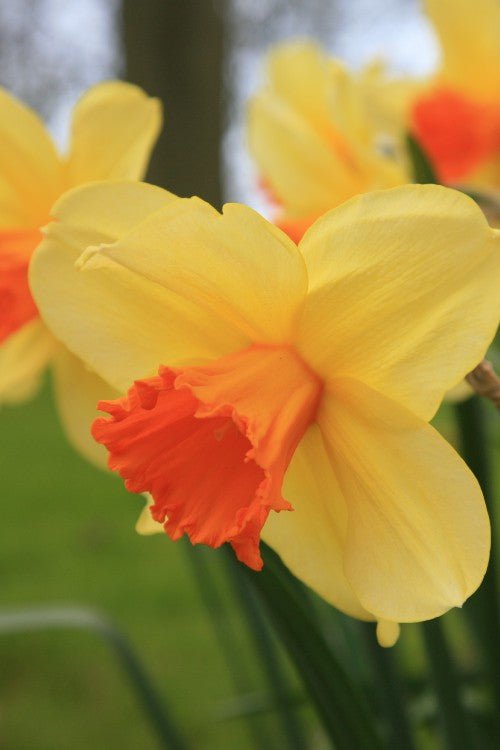Explore the Daffodils collection - Spring Flowering bulbs
Sort by:
About Baby Boomer
Discover the exquisite beauty of the Daffodil Baby Boomer! This enchanting flower will captivate your senses with its vibrant colors and delightful fragrance. Whether you're an experienced gardener or a budding enthusiast, this remarkable variety is perfect for adding a touch of elegance to your garden or indoor space.
- Stunning blooms in buttery yellow, creating a striking visual display.
- Compact size, making it ideal for small gardens, containers, or indoor pots.
- Easy to grow, requiring minimal maintenance and attention.
- Early blooming, bringing a burst of color to your surroundings in the spring.
- Long-lasting flowers that continue to charm for an extended period.
How to plant and take care of Baby Boomer
- Choose a well-draining location with partial to full sun exposure.
- Dig a hole that is two to three times the depth of the bulb.
- Place the bulb in the hole with the pointed end facing upwards.
- Cover the bulb with soil, firming it gently to remove air pockets.
- Water thoroughly after planting and keep the soil slightly moist.
- Provide regular watering during dry spells.
- Apply a balanced fertilizer once a month during the growing season.
- Deadhead faded blooms to encourage new flower production.
- After the blooming period, allow the foliage to die back naturally.
- Avoid cutting or removing the leaves until they turn yellow.
- Mulch the area around the bulbs to protect them during winter.
About Barret Browning
Discover the exquisite beauty of the Daffodil Barret Browning, a stunning addition to any garden. This vibrant and elegant flower is sure to captivate your senses with its vibrant hues and delicate petals.
- Striking white blooms with a contrasting orange trumpet
- Hardy and long-lasting flowers that bloom in early spring
- Ideal for borders, containers, or naturalizing in meadows
- Low-maintenance plant that thrives in full sun to partial shade
- Deer and rodent resistant, ensuring a flourishing display
How to plant and take care of Barret Browning
- Choose a well-draining location with fertile soil
- Plant bulbs in the fall, 4-6 inches deep and 4-6 inches apart
- Water thoroughly after planting and keep the soil evenly moist
- Apply a balanced fertilizer in early spring to promote healthy growth
- Deadhead faded flowers to encourage additional blooms
- After blooming, allow the foliage to wither naturally before trimming it back
About Bright Corsage
Bring bold color and cheerful charm to your spring garden with the large cupped daffodil Bright Corsage. This standout variety features soft yellow petals with a bright, large, apricot-orange cup that adds warmth and energy to any flower bed or container. Known for its strong stems and long-lasting blooms, Bright Corsage is perfect for cut flower arrangements and naturalizing in sunny spots.
-
Eye-catching yellow petals with a vivid orange cup
-
Large, long-lasting blooms in early to mid spring
-
Strong, wind-resistant stems
-
Great for garden borders, containers, and cut flowers
-
Deer and rabbit resistant
How to plant and take care of large cupped daffodil Bright Corsage:
-
Choose a sunny or partly shaded location with well-drained soil
-
Plant bulbs in fall, 6 inches deep and 4–6 inches apart
-
Water after planting and keep soil lightly moist during growth
-
Allow foliage to die back naturally after blooming to feed next year’s bulbs
-
Fertilize lightly in early spring with a balanced bulb food
-
Avoid overwatering or soggy soil to prevent rot
About Bright Jewel
Brighten up your garden with the exquisite beauty of the Daffodil Bright Jewel. These captivating flowers will add a touch of elegance and charm to any outdoor space.
- Vibrant and eye-catching blooms
- Rich golden-yellow petals with contrasting orange cups
- Compact and sturdy stems
- Early spring blooming, bringing a burst of color after the winter months
- Easy to grow and low maintenance
How to plant and take care of Bright Jewel
- Choose a sunny or partially shaded location with well-drained soil
- Plant bulbs in the fall, around 4-6 inches deep and 3-6 inches apart
- Water thoroughly after planting and keep the soil moist but not waterlogged
- Fertilize once a year in the early spring with a balanced bulb fertilizer
- Deadhead spent flowers to promote continued blooming
- Allow the foliage to naturally die back after blooming to nourish the bulbs for the next season
- Protect from extreme cold temperatures by adding a layer of mulch in late fall
About Broadway Star
Experience the enchanting beauty of the Daffodil Broadway Star! This stunning flower is a must-have addition to any garden or floral arrangement. With its vibrant hues and graceful petals, it is sure to captivate your senses.
- Striking yellow and white petals with a delightful trumpet-shaped center
- Heightens the visual appeal of gardens, borders, and flower beds
- Excellent cut flowers for bouquets and indoor arrangements
- Easy to grow and low maintenance, making it ideal for both experienced gardeners and beginners
How to plant and take care of Broadway Star
- Choose a sunny or partially shaded location in well-drained soil
- Dig a hole approximately 4-6 inches deep and place the bulb with the pointed end facing up
- Space the bulbs about 4 to 6 inches apart to allow proper growth
- Water the bulbs thoroughly after planting and keep the soil moist but not waterlogged
- Apply a balanced fertilizer during the growing season to encourage healthy blooms
- Deadhead the flowers once they fade to promote continuous blooming
- After the flowering season, allow the foliage to die back naturally before removing it
About Carlton
Experience the vibrant beauty of the Daffodil Carlton, a stunning addition to any garden. With its large, golden-yellow blooms and graceful, trumpet-shaped flowers, this variety is sure to captivate your senses.
- Large, golden-yellow blooms
- Elegant trumpet-shaped flowers
- Vibrant and eye-catching
- Hardy and long-lasting
- Perfect for borders, containers, and cut flower arrangements
How to plant and take care of Carlton
- Choose a sunny or partially shaded location for planting
- Plant bulbs in the fall, about 4-6 inches deep and 4-6 inches apart
- Ensure well-drained soil to prevent waterlogging
- Water thoroughly after planting and keep the soil moist but not waterlogged during the growing season
- Apply a balanced fertilizer in early spring and again after flowering
- Remove faded flowers to encourage more blooms and prevent seed formation
- Allow the foliage to die back naturally before removing it
- Protect bulbs from excessive moisture during the dormant period
About Cha-Cha
The miniature Daffodil Cha-Cha adds a touch of elegance and cheer to any garden. With its beautiful, compact blooms and white petals with orange cup, it’s perfect for adding color to rock gardens, borders, or containers. These cheerful daffodils are a spring favorite, offering a delightful display year after year.
-
Vibrant blooms: stunning white flowers with orange cup, bring brightness to your garden.
-
Compact size: perfect for rock gardens, containers, or smaller spaces.
-
Long-lasting: enjoy these daffodils year after year with minimal care.
-
Resilient: tolerates a variety of soil types and weather conditions.
-
Easy to grow: low-maintenance and great for beginner gardeners.
How to plant and take care of Miniature Daffodil Cha-Cha:
-
Planting depth: set the bulbs 3-4 inches deep in well-drained soil.
-
Spacing: space bulbs 4-6 inches apart to allow room for growth.
-
Sunlight: ensure full sun exposure for the best blooms.
-
Watering: water regularly, keeping the soil moist but not soggy.
-
Fertilization: apply a balanced fertilizer in early spring to encourage healthy growth.
-
Winter care: mulch lightly in colder climates to protect the bulbs from freezing.
About Cheerfulness
Experience the vibrant beauty of Daffodil Cheerfulness in your garden! These delightful white with orange crown flowers will brighten up any space with their sunny disposition and enchanting fragrance. With their captivating charm, Daffodil Cheerfulness is perfect for adding a touch of joy to your outdoor landscape.
- Gorgeous blooms that exude cheerfulness and radiate positive energy
- Aromatic fragrance that creates an inviting atmosphere
- Hardy and resilient, thriving in various climates
- Long-lasting flowers that return year after year
- Easy to grow and maintain, suitable for both beginners and experienced gardeners
How to plant and take care of Cheerfulness
- Choose a well-drained location with partial to full sunlight
- Dig a hole approximately twice the depth of the bulb
- Place the bulb in the hole with the pointed side up
- Cover the bulb with soil and gently press it down
- Water thoroughly after planting and keep the soil evenly moist
- Ensure proper drainage to prevent waterlogging
- Apply a balanced fertilizer during the growing season
- Remove spent flowers to encourage more blooms
- Allow foliage to die back naturally before cutting it back
- Protect from extreme temperatures or excessive moisture
About Color Magic
Transform your garden with the magical Daffodil Color Magic. Color Magic is a Large Cupped Daffodil which means it has super large flower cups that are easy to love. Whether you're a beginner or an expert gardener, this daffodil is perfect for you. It's simple but stunning, making your garden a charming place for everyone.
- Pop of color: Color Magic daffodils have beautiful colors, from sunny yellows to an orange cup.
- Long blooming time: these flowers stay in bloom for a long time, keeping your garden lively throughout the spring.
- Easy to care for: Color Magic is tough and doesn't need a lot of attention. It grows well in different soils, and you don't need to be an expert to make it thrive.
- Fits anywhere: perfect for borders, pots, or spreading naturally, this daffodil is versatile and can fit any part of your garden.
How to plant and take care of Daffodil Color Magic
- Planting depth: pt the bulbs 6-8 inches down in soil that drains well.
- Spacing: give each bulb 4-6 inches of space for the best growth.
- Sunlight: plant them where they get lots of sun, but they can also handle a bit of shade.
- Watering: keep the soil moist but not too wet while they're growing.
- Fertilization: give them a balanced fertilizer in the early spring to help them grow strong and healthy.
About Dick Wilden
Experience the vibrant beauty of Daffodil Dick Wilden, a stunning addition to any garden. This exquisite orange flower variety boasts captivating colors and graceful blooms that will brighten up your outdoor space. Here are the key features of Daffodil Dick Wilden:
- Captivating beauty: Admire the elegant blooms and vibrant colors of Daffodil Dick Wilden, adding a touch of charm to your garden.
- Long-lasting blooms: Enjoy extended flowering periods, with Daffodil Dick Wilden bringing joy to your garden for weeks on end.
- Hardy and reliable: These daffodils are resilient and thrive in a variety of climates, making them easy to grow and care for.
How to plant and take care of Dick Wilden
- Choose a sunny or partially shaded spot in your garden for planting.
- Dig a hole that is two to three times the depth of the bulb and place the bulb in the hole with the pointed end facing upwards.
- Cover the bulb with soil and water thoroughly after planting.
- Water regularly, ensuring the soil remains moist but not waterlogged.
- Provide well-drained soil and avoid overwatering to prevent bulb rot.
- Apply a balanced fertilizer in early spring to promote healthy growth.
- Remove spent blooms to encourage further flowering.
- After the blooming season, allow the foliage to wither naturally before trimming it back.
About Dutch Master
Experience the vibrant beauty of the Daffodil Dutch Master! These stunning flowers will brighten up any garden or floral arrangement with their bold colors and graceful blooms.
- Gorgeous blooms in vibrant shades of yellow
- Large, sturdy flowers with ruffled edges
- Long-lasting blooms that bring joy year after year
- Perfect for borders, containers, and cut flower arrangements
- Hardy and easy to grow
How to plant and take care of Dutch Master
- Choose a sunny or partially shaded location with well-draining soil
- Plant bulbs in the fall, around 4-6 inches deep and 4-6 inches apart
- Water thoroughly after planting and keep the soil evenly moist during the growing season
- Fertilize with a balanced flower fertilizer in early spring and after flowering
- Deadhead spent flowers to encourage more blooms
- Allow the foliage to die back naturally before removing it
- Protect bulbs from extreme cold with a layer of mulch in winter
About Falmouth Bay
Add bold, cheerful beauty to your spring garden with the large cupped daffodil Falmouth Bay. This stunning variety features creamy white petals with a large cup. Perfect for garden beds, borders, and cut flower arrangements, it blooms in early to mid-spring and brings a fresh burst of color after winter. A favorite among pollinators, this daffodil is easy to grow and naturalizes well year after year.
-
Bright white flowers with a large cup
-
Blooms in early to mid-spring for a vibrant seasonal display
-
Great for cutting and indoor arrangements
-
Deer and rabbit resistant
-
Comes back year after year with minimal care
How to plant and take care of large cupped daffodil Falmouth Bay:
-
Plant bulbs in fall, about 6 inches deep and 4–6 inches apart
-
Choose a sunny or lightly shaded location with well-drained soil
-
Water after planting and keep soil slightly moist during the growing season
-
Allow leaves to die back naturally to feed next year’s blooms
-
Avoid overwatering to prevent bulb rot
-
Apply bulb fertilizer in early spring for best results
About February Gold
Experience the radiant beauty of the Daffodil February Gold! This exquisite flower is a must-have addition to any garden, bringing vibrant hues and a delightful fragrance.
- Gorgeous golden-yellow petals with a sunny center
- Compact size, perfect for borders, containers, or rock gardens
- Early blooming variety, adding a burst of color to your landscape
- Hardy and easy to grow, suitable for both novice and experienced gardeners
- Long-lasting blooms that return year after year, enhancing the charm of your garden
How to plant and take care of February Gold
- Plant the bulbs in well-drained soil in autumn, around 4-6 inches deep and 3-6 inches apart.
- Choose a sunny or partially shaded location for optimal growth.
- Water thoroughly after planting and keep the soil moist but not waterlogged.
- Apply a balanced fertilizer in early spring to promote healthy growth.
- Deadhead faded flowers to encourage the plant's energy toward bulb development.
- Allow the foliage to naturally wither before removing it, as it helps the bulb store energy for the next blooming season.
- Protect the bulbs from excessive moisture during the dormant period.
- Enjoy the stunning display of golden blooms year after year with minimal maintenance.
About Flower Drift
Experience the breathtaking beauty of the Daffodil Flower Drift in your garden. This vibrant and elegant perennial is the perfect addition to any landscape, adding a touch of sophistication and charm. With its delicate yellow petals and graceful green foliage, the Daffodil Flower Drift will captivate your senses and create a stunning visual display.
- Vibrant yellow petals and graceful green foliage
- Perennial plant that blooms year after year
- Low maintenance and easy to grow
- Ideal for borders, flower beds, and containers
- Suitable for both beginner and experienced gardeners
How to plant and take care of the Flower Drift
- Choose a sunny location with well-drained soil
- Plant bulbs in the fall, about 4-6 inches deep and 4-6 inches apart
- Water regularly during the growing season, keeping the soil moist but not waterlogged
- Apply a balanced fertilizer in early spring to promote healthy growth
- Deadhead faded flowers to encourage more blooms
- After the flowering season, allow the foliage to wither naturally before trimming it back
About Fortissimo
Find out why everyone loves this Fortissimo Daffodil so much. It is the perfect addition to your garden. With its yellow petals, and orange cup, this Daffodil will make your garden look forte!
- Large, vibrant blooms that make a stunning statement
- Long-lasting flowers that add beauty to your outdoor space
- Robust and reliable, thriving in various climates
- Easy to grow, ideal for both beginners and experienced gardeners
- Versatile and adaptable, suitable for beds, borders, and containers
How to plant and take care of Fortissimo
- Choose a sunny or partially shaded spot in your garden
- Dig a hole that is 4-6 inches deep
- Place the bulb in the hole with the pointed end facing up
- Cover the bulb with soil and gently firm it down
- Water thoroughly after planting and keep the soil moist
- Provide regular watering during dry spells
- Apply a balanced fertilizer during the growing season
- Deadhead spent flowers to promote new growth
- Allow the foliage to die back naturally before removing it
- Protect from extreme frost by mulching in colder regions
About Geranium
This stunning Daffodil Geranium will add a burst of color to any garden or outdoor space. With its eye-catching petals and lush foliage, it's sure to impress both avid gardeners and beginners alike.
- Striking and vibrant white with orange blooms
- Beautifully contrasting colors that catch the eye
- Lush foliage for added visual appeal
- Thrives in both sunny and partially shaded areas
- Easy to grow and low maintenance
How to plant and take care of Geranium
- Choose a well-draining soil for optimal growth
- Plant in a location that receives morning sun and afternoon shade
- Dig a hole slightly larger than the plant's root ball and place it in the hole
- Backfill with soil and gently firm it around the plant
- Water thoroughly after planting and keep the soil moist but not waterlogged
- Deadhead spent flowers regularly to encourage continuous blooming
- Apply a balanced fertilizer during the growing season to promote healthy growth
- Protect from frost in colder climates by covering or moving indoors
About Golden Salome
Experience the enchanting beauty of the Daffodil Golden Salome, a captivating addition to any garden or floral arrangement. With its vibrant golden-yellow petals and delicate, trumpet-shaped blooms, this daffodil variety is sure to make a lasting impression.
- Vibrant golden-yellow petals
- Delicate trumpet-shaped blooms
- Captivating addition to gardens or floral arrangements
How to plant and take care of Golden Salome
- Choose a sunny location with well-drained soil for planting.
- Dig a hole that is two times the height of the bulb and place the bulb in the hole with the pointed end facing upward.
- Cover the bulb with soil and water thoroughly.
- Water regularly, keeping the soil moist but not waterlogged.
- Fertilize with a balanced bulb fertilizer in early spring and after flowering.
- Deadhead faded blooms to encourage new growth.
- Allow the foliage to die back naturally before removing it.
About Hillstar
Brighten up your garden with the vibrant and charming Daffodil Hillstar. This exquisite variety of daffodils is sure to add a touch of elegance to any outdoor space. With its delicate yellow petals and contrasting orange center, the Hillstar variety is a true showstopper.
- Beautiful and vibrant yellow petals with an eye-catching orange center
- Medium-sized blooms that add a pop of color to your garden
- Hardy and reliable, perfect for both novice and experienced gardeners
- Long-lasting flowers that bloom in early spring, bringing the first signs of the season
- Versatile plant that thrives in various garden settings, from borders to containers
How to plant and take care of Hillstar
- Choose a sunny or partially shaded location in your garden.
- Dig a hole that is 4-6 inches deep and place the bulb with the pointed end facing upwards.
- Space the bulbs approximately 4-6 inches apart to allow for proper growth.
- Water the bulbs thoroughly after planting to settle the soil.
- Provide regular watering during the growing season, especially during dry spells.
- Deadhead the flowers after they fade to encourage more blooms.
- Let the foliage die back naturally before removing it, as it helps store energy for the next season.
- Apply a slow-release bulb fertilizer in early autumn to promote healthy growth.
FAQs



